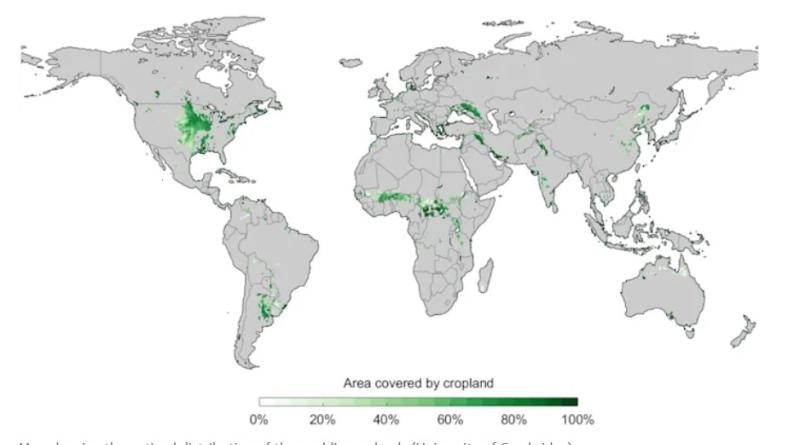Relocate farms and cut their carbon footprints by 70%, scientists say

Scientists remap global farmland to reveal ‘optimal scenario’ for reducing impacts on climate.
The carbon impact of the world's crops could theoretically be cut by 71 per cent by relocating farms, turning them into highly-mechanised intensive operations, and allowing the farmland left behind to return to a natural state, new research suggests.
Scientists at the University of Cambridge produced a map showing the world's existing, extensive farmland, and also produced a second map showing how less land could be used to feed the global population.
The reimagined map includes large new farming areas for many major crops around the so-called Corn Belt in the US Midwest, and in Africa, below the Sahara desert. Huge areas of farmland in Europe and India would be restored to natural habitat.
The result would be a cut in carbon emissions equivalent to capturing twenty years’ worth of our current net CO2 emissions, the researchers said.
Reforesting farmland would mean that trees capture carbon as they grow, and help more carbon to be captured by the soil than when crops are grown in it, the study said.
In this scenario, the impact of crop production on the world’s biodiversity would be reduced by 87 per cent.
This would drastically reduce the extinction risk for many species, for which agriculture is a major threat. The researchers said croplands would quickly revert back to their natural state, often recovering their original carbon stocks and biodiversity within a few decades.
First author of the paper, Dr Robert Beyer, formerly of the University of Cambridge, but now based at the Potsdam Institute for Climate Impact Research in Germany, said: “In many places, cropland has replaced natural habitat that contained a lot of carbon and biodiversity – and crops don’t even grow very well there. If we let these places regenerate, and moved production to better suited areas, we would see environmental benefits very quickly.“
The team said the study is the first to plot the relocation of agricultural land to maximise long-term environmental benefits without compromising food security.
Admitting that a complete global relocation of cropland is ”clearly not a scenario that could currently be put into practice“, the scientists said their models highlight places where croplands are currently very unproductive, but have potential to be hotspots for biodiversity and carbon storage.
They said that even taking a pared-back approach and only redistributing croplands within national borders, rather than globally, would still result in significant benefits, such as a global carbon impact reduction of 59 per cent and a biodiversity impact 77 per cent lower than at present.
They said an ”even more realistic option“ of only relocating the worst-offending 25 per cent of croplands would result in half of the benefits of optimally moving all croplands.
“It’s currently not realistic to implement this whole redesign,” said Dr Beyer.
“But even if we only relocated a fraction of the world’s cropland, focusing on the places that are least efficient for growing crops, the environmental benefits would be tremendous.”
Author: Harry Cockburn






